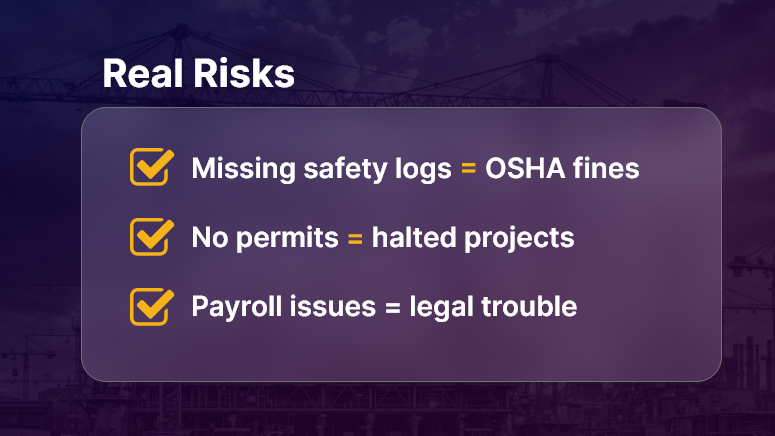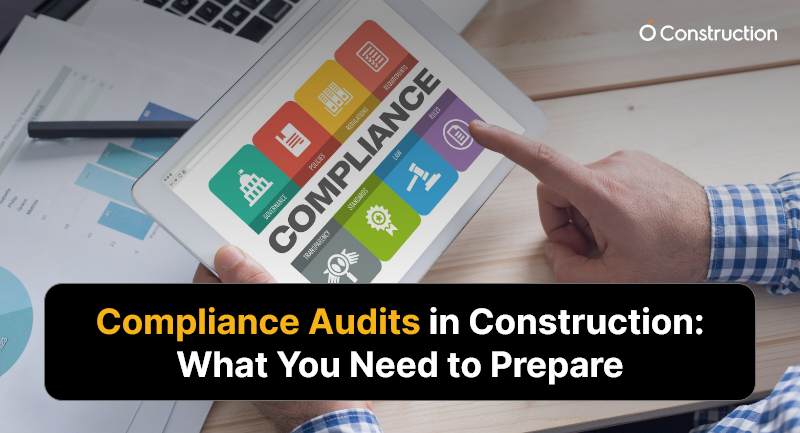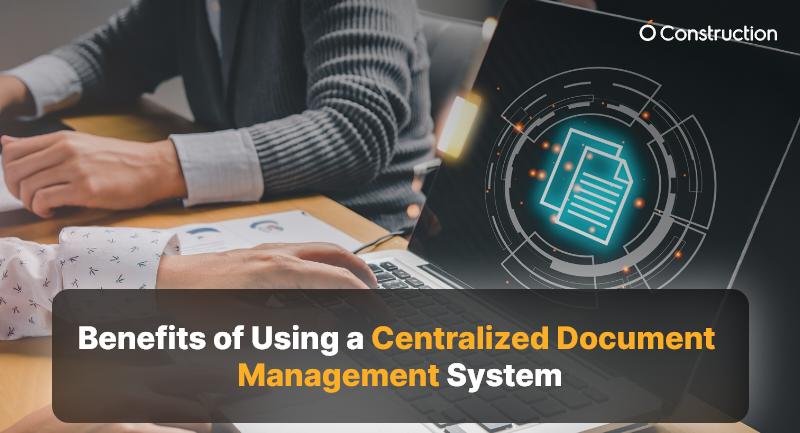Imagine pouring months into a construction project — only to be halted mid-progress due to missing paperwork or non-compliance with regulatory norms. It’s more common than you think. Compliance audits in construction are no longer rare events — they’re routine checks that could define your project’s timeline and profitability. Audits cover everything from worker safety to environmental regulations, and failing one can lead to costly penalties or even shutdowns.
In this blog, you’ll learn:
- What compliance audits in construction involve
- Why they matter now more than ever
- How you can prepare (and pass) with confidence
Let’s help you get audit-ready, with smart planning and the right tools.

Why Compliance Audits in Construction Matter?
Construction is a high-risk, highly regulated industry. Every stakeholder — contractors, owners, subcontractors, and suppliers — must comply with safety, labor, environmental, and building codes. Audits ensure these rules are followed.
Why Should Construction Companies Care?
- Reputation at Stake: Non-compliance can lead to fines, lawsuits, and damage to your brand.
- Delays Hurt the Bottom Line: Projects that stall due to audit failures lose money fast.
- Liability Protection: Audits verify that your processes protect workers, the public, and your company from harm.
Who Benefits Most?
- General contractors gain better project visibility and control.
- Compliance officers avoid scrambling last-minute for documents.
- Project managers keep timelines on track by anticipating risks.
Real-World Scenarios
- Workplace Safety Check: An OSHA inspector visits your site after a reported incident. Missing safety logs or expired PPE certifications? Expect fines.
- Environmental Review: During a road expansion project, missing impact assessments delay permits.
- Labor Compliance: A government audit reveals underpaid workers and a lack of labor law posters — your entire payroll could be under scrutiny.
Compliance audits in construction aren’t optional — they’re operational necessities.
How to Prepare for Construction Compliance Audits?
Preparation is your best defense. Here’s a deep dive into actionable strategies and industry best practices to keep your project audit-ready.
1. Build a Digital Documentation System
- Store permits, drawings, safety records, and inspection reports in one secure, searchable system.
- Make documents accessible to authorized users anytime, anywhere.
- Tools like OConstruction help digitize and organize records by project or site.
2. Conduct Internal Pre-Audits Regularly
- Perform routine checks using audit checklists before external auditors arrive.
- Identify gaps in safety, labor, or environmental compliance.
- Keep track of action items and close the loop before issues escalate.
3. Maintain Accurate Safety Records
- Update safety training logs and toolbox talk records on a weekly basis.
- Track incident reports, near misses, and corrective actions in real time.
- Use mobile access for foremen or supervisors to submit reports directly from the site.
4. Stay on Top of Regulatory Changes
- Compliance standards change often — especially labor and environmental ones.
- Assign a compliance lead to monitor updates and apply changes proactively.
- Subscribe to regulatory bulletins (like OSHA News).
5. Assign Clear Roles and Accountability
- Identify who is responsible for compliance on each project.
- Define escalation workflows — what happens when a non-compliance is spotted?
- Use a project dashboard to show compliance status in real time.
6. Audit Trail Management
- Ensure every action — approvals, sign-offs, safety inspections — is timestamped and traceable.
- Automate notifications and reminders for expiring documents or upcoming inspections.
7. Standardize Procedures Across Sites
- Use repeatable checklists and templates to standardize workflows.
- Train site leads and supervisors in audit preparation practices.
- Store audit SOPs centrally for easy reference.
Use Case: How One Company Passed a Surprise Audit
For example, MetroBuild Infra, a mid-sized infrastructure firm, used OConstruction’s audit-ready checklist and digital safety logs to pass a surprise regulatory audit during a highway overpass project.
- Before: Scattered files, missed deadlines, last-minute scrambling.
- After: Centralized records, proactive alerts, 98% compliance audit score.
- Result: Avoided shutdown, improved trust with regulators, and kept the project on schedule.
Here’s how: Their compliance officer used OConstruction to run weekly internal audits, submit safety documentation through mobile devices, and store environmental certificates in a centralized document vault—available instantly during the inspection.
Key Takeaways
1. Compliance audits in construction are not optional — they’re critical.
They affect safety, finances, timelines, and your ability to win future projects.
2. Preparation is not just about documents — it’s about systems.
When you standardize procedures, assign roles, and go digital, you’re ready anytime.
3. Digital tools simplify compliance.
OConstruction offers real-time dashboards, document management, mobile reporting, and internal audit templates to keep your team compliant without chaos.


